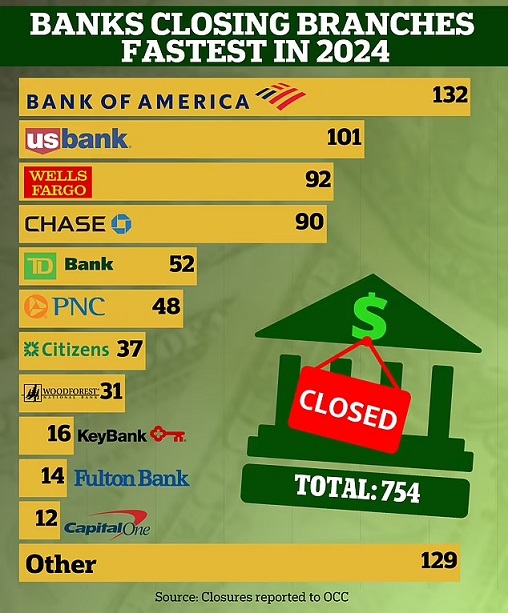Major banks shut down locations, signaling shifts in banking trends and customer preferences.
In the first two weeks of October, U.S. banks closed 46 local branches, reflecting broader changes in the banking industry. The closures come as more customers move to online banking and digital services, forcing banks to reduce their physical presence.
Citizens Bank Leads the Pack with Fifteen Closures
Citizens Bank was responsible for the most closures during this period, shutting down fifteen branches in just two weeks. These closures highlight the bank’s shift toward digital banking services. As more customers rely on mobile apps and online banking, physical branches have become less critical to the bank’s overall strategy. By closing these branches, Citizens Bank aims to streamline its operations and cut costs.
Huntington Bank Follows with Eleven Closures
Huntington Bank also closed eleven branches between October 1 and October 14. Like Citizens, Huntington is adjusting to a rapidly changing market where in-person banking services are in less demand. With customers preferring digital services, banks are choosing to close underperforming branches to focus on more profitable areas.

U.S. Bank Shuts Down Nine Locations
U.S. Bank followed with nine branch closures during the same period. The bank has steadily reduced its brick-and-mortar locations, aligning with the growing trend toward digital financial services. These closures reflect the bank’s ongoing efforts to optimize its operations and better serve its tech-savvy customer base.
Bank of America and Wells Fargo Each Close Four Branches
Both Bank of America and Wells Fargo closed four branches each during the first two weeks of October. While these banks remain major players in the U.S. financial landscape, their closures underscore the industry’s pivot away from traditional banking models. By reducing the number of physical branches, these institutions aim to invest more in digital technologies that better meet customer needs.
First National Bank of Texas and Chase Each Close One Branch
First National Bank of Texas and Chase were the smallest contributors to the recent wave of closures, each shutting down one branch. Though smaller in scale, these closures still reflect a larger trend affecting banks of all sizes. As customer preferences shift, even smaller regional players are finding that maintaining a large network of physical branches is no longer necessary.
A Broader Shift Toward Digital Banking
The recent closures by major U.S. banks illustrate a broader industry shift toward digital banking. As more customers handle their finances online, the need for physical locations continues to decline. Banks are responding by closing underperforming branches and investing more in online platforms and mobile apps. This trend is likely to continue as financial institutions seek to modernize their services and stay competitive in a digital-first world.
The rapid pace of these closures shows how quickly the banking landscape is changing. With 46 branches closed in just two weeks, banks are making bold moves to adapt to the evolving needs of their customers. The future of banking is increasingly digital, and these closures are a reflection of that reality.




